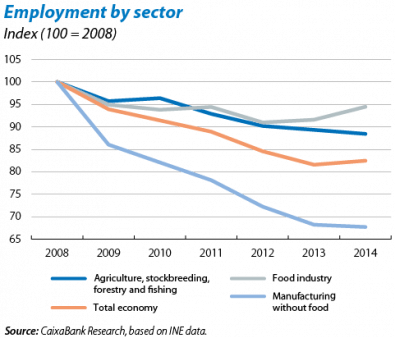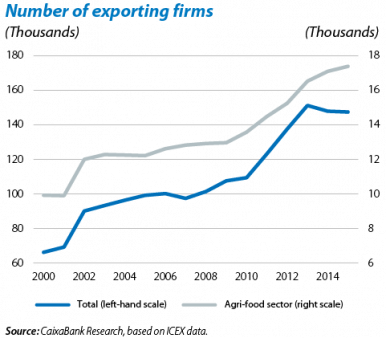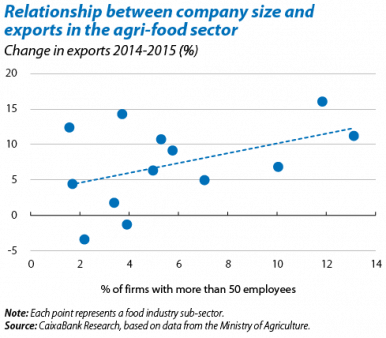In spite of its secular trend towards tertiarisation, the agri-food sector is a fundamental pillar for Spain's economy. Although primary sectors have gradually lost share,1 the food industry, responsible for producing processed foods with greater value added, has kept its contribution at around 3.0% of total GVA and has consolidated its position as the leading industrial branch: contributing 22.3% of the GVA for manufacturing in 2014 and employing 430,400 people. Also notable is the fact that the number of people employed by this branch has not fallen as much as in other sectors (see the first graph).
One of the supports for this good performance by the agri-food sector is the continued rise in exports. Averaging 6.5% growth in the last 10 years, higher than the 5.1% achieved by the rest of the sectors, it totalled 40.5 billion euros in 2015 (16.2% of all goods exported), a figure on a par with the 42.6 billion recorded by the automobile industry. The internationalisation of companies in this sector has been spectacular: 17,375 firms exported food to the rest of the world in 2015, almost doubling the figure recorded in 2000 of 10,000 firms and, unlike the stabilisation observed in the total number of exporting firms in the two last years, this industry has continued its upward trend (see the second graph).
With a 40% share of all agri-food exports, fruit and vegetables make up most of these foreign sales, with Spain being known as the «garden of Europe». But the range of products exported is widening and with increasing value added. The sector has also been able to increase and develop its range of destinations: although the euro area is still the destination for most food exports (60.0% in 2015), its share has been falling in favour of more distant markets such as Asia, Africa and Latin America (8.6%, 4.3% and 2.8% respectively in 2015). This positive trend in the sector has helped Spain to remain eighth in the world ranking of countries exporting agri-food products.2
In spite of these achievements, which are largely thanks to the modernisation carried out and the increased use of technology, the industry is still highly fragmented: only 3.6% of companies in the food industry employ more than 50 people. An analysis of the sub-sectors in the food industry reveals that exports grew more in those with a higher proportion of large firms (see the third graph). Increasing company size is therefore one way of continuing to improve the competitiveness of agri-food companies in an increasingly global market.
1. The share of GVA for agriculture, stockbreeding, forestry and fishing fell from 4.2% in 1995 to 2.5% in 2014. In terms of full-time equivalent employment, the reduction in its share was even greater: from 7.3% to 4.2%, although it still employs 685,500 people.
2. Spain' share in the world market of agri-food goods is 3.1%, higher than its 1.7% share for total goods (WTO).





